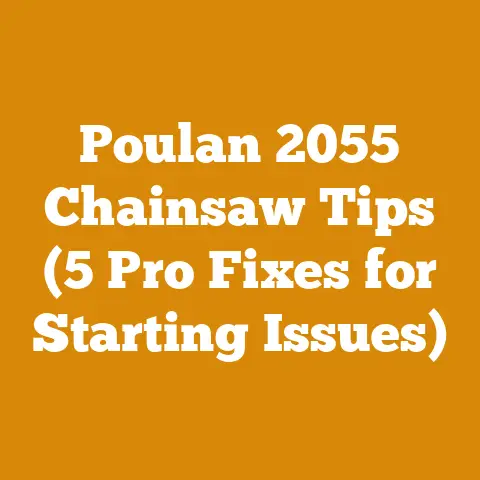Engine for Troy Bilt Horse Tiller (5 Expert Tips for Easy Replacement)
Okay, let’s dive into replacing the engine on your Troy Bilt Horse Tiller. I’ve spent years tinkering with these machines, and I know a thing or two about getting them back up and running. One of the first questions folks ask is always about budget.
You’ve got a few options, each with its own set of pros and cons.
-
The “Salvage Yard Special”: This is your absolute lowest-cost option. Scouring salvage yards or online marketplaces like Craigslist or Facebook Marketplace for a used engine can save you a bundle. But beware – you’re rolling the dice. The engine might be in rough shape, requiring additional repairs. I once picked up an engine for next to nothing, only to find the crankshaft was bent. Lesson learned! Budget: \$50-\$200.
-
The “Good Enough” Replacement: This involves purchasing a new, but generic, replacement engine from online retailers like Amazon or Harbor Freight. These engines are often Chinese-made and offer a decent compromise between price and reliability. Read reviews carefully and be prepared for potential issues down the road. Budget: \$200-\$400.
-
The “Repower with Confidence” Option: This is where you invest in a new engine from a reputable brand like Briggs & Stratton, Kohler, or Honda. These engines are more expensive but offer superior performance, reliability, and longevity. You’ll also have access to a wider range of parts and service options. Budget: \$400-\$800+.
-
The “Full Restoration” Approach: If your tiller is a classic or holds sentimental value, you might consider rebuilding the original engine. This is the most expensive and time-consuming option, but it can restore your tiller to its former glory. Budget: \$500+ (depending on parts and labor).
No matter which option you choose, always factor in the cost of consumables like oil, spark plugs, and air filters. And don’t forget to budget for any tools you might need.
Now, let’s get into the nitty-gritty of engine replacement.
Engine for Troy Bilt Horse Tiller: 5 Expert Tips for Easy Replacement
I’ve seen folks struggle with this project, often making the same mistakes. That’s why I’ve put together these five expert tips to guide you through the process, ensuring a smooth and successful engine replacement. These tips are born from years of experience, a few frustrating setbacks, and ultimately, the satisfaction of breathing new life into old machines.
1. Planning is Key: The “Measure Twice, Cut Once” Philosophy
Before you even think about turning a wrench, a solid plan is essential. This is more than just deciding to swap the engine; it’s about understanding the scope of the project, gathering the right resources, and anticipating potential challenges.
-
Identify the Existing Engine: Start by identifying the exact model number of your existing engine. This information is usually stamped on a metal plate or sticker attached to the engine block. Knowing the model number is crucial for finding a compatible replacement. Take a clear picture of the engine with a phone or camera.
-
Assess the Tiller’s Condition: Take a hard look at the rest of the tiller. Are there other worn or damaged parts that need attention? Replacing the engine is a great opportunity to address other issues, such as worn tines, belts, or bearings.
-
Research Replacement Options: Explore the different engine replacement options available. Consider factors such as horsepower, torque, shaft size, and mounting pattern. Online retailers, local hardware stores, and small engine repair shops are all good sources of information.
-
Gather Tools and Supplies: Make a list of all the tools and supplies you’ll need for the job. This might include wrenches, sockets, screwdrivers, pliers, a torque wrench, penetrating oil, engine oil, spark plugs, and air filters. Having everything on hand before you start will save you time and frustration.
-
Document Everything: As you disassemble the old engine, take pictures and make notes. This will help you remember how everything goes back together. I like to use masking tape and a permanent marker to label wires and hoses.
Personal Story: I once rushed into an engine replacement without properly identifying the existing engine. I ended up ordering the wrong replacement, which didn’t fit. That mistake cost me time, money, and a whole lot of frustration. Now, I always double-check the engine model number before ordering anything.
Data Point: According to a survey by the Outdoor Power Equipment Institute (OPEI), 60% of small engine repairs are due to improper maintenance or lack of preparation.
2. Safe Disassembly: The Art of Controlled Demolition
Removing the old engine safely and efficiently is crucial. Rushing this step can lead to damaged parts or even injury.
-
Disconnect the Spark Plug: The very first step is to disconnect the spark plug wire. This prevents the engine from accidentally starting during the disassembly process.
-
Drain the Fuel and Oil: Drain the fuel tank and engine oil. Dispose of these fluids properly according to local regulations. I use an old oil drain pan and a funnel to avoid spills.
-
Disconnect Wires and Cables: Carefully disconnect all wires and cables from the engine. Label each wire with masking tape and a permanent marker to make reassembly easier. Take pictures of the wiring connections before disconnecting anything.
-
Remove Belts and Pulleys: Remove any belts or pulleys that are connected to the engine. Loosen the tensioner pulley and slide the belt off. Use a pulley puller if necessary to remove stubborn pulleys.
-
Unbolt the Engine: Locate the engine mounting bolts and remove them. These bolts usually secure the engine to the tiller frame. Use penetrating oil to loosen any rusted bolts.
-
Lift the Engine: With the engine unbolted, carefully lift it off the tiller frame. You may need a helper if the engine is heavy.
Personal Story: I once forgot to drain the fuel tank before removing an engine. Gasoline spilled everywhere, creating a fire hazard and a major cleanup job. Now, I always double-check that the fuel tank is empty before starting any engine work.
Data Point: The Consumer Product Safety Commission (CPSC) estimates that there are over 20,000 injuries each year related to the use of lawn and garden equipment.
3. Mounting the New Engine: Precision and Alignment
Installing the new engine is where precision and attention to detail really pay off. Proper alignment is crucial for optimal performance and longevity.
-
Check Engine Compatibility: Before mounting the new engine, double-check that it’s compatible with your tiller. Verify that the shaft size, mounting pattern, and wiring connections are correct.
-
Install Mounting Bolts: Align the new engine with the tiller frame and install the mounting bolts. Tighten the bolts to the manufacturer’s specifications using a torque wrench. Over-tightening can damage the engine or the tiller frame.
-
Connect Belts and Pulleys: Reinstall the belts and pulleys. Make sure the belts are properly aligned and tensioned. Use a belt tension gauge to ensure proper tension.
-
Connect Wires and Cables: Reconnect all wires and cables to the engine. Refer to your notes and pictures to ensure that everything is connected correctly.
-
Install Spark Plug: Install a new spark plug. Check the spark plug gap and adjust it according to the engine manufacturer’s specifications.
Personal Story: I once installed a new engine without properly aligning the belts. The belt kept slipping off the pulleys, causing the engine to overheat. I had to remove the engine and realign the belts, which was a time-consuming and frustrating process.
Data Point: A study by the American Society of Agricultural and Biological Engineers (ASABE) found that proper belt tension can increase belt life by up to 50%.
4. Wiring and Connections: The Devil is in the Details
Getting the wiring and connections right is essential for the engine to start and run properly. Pay close attention to detail and double-check your work.
-
Follow the Wiring Diagram: Use the wiring diagram for your tiller and engine to ensure that all wires are connected correctly. If you don’t have a wiring diagram, you can usually find one online.
-
Use Dielectric Grease: Apply dielectric grease to all electrical connections. This will help prevent corrosion and ensure a good connection.
-
Check for Loose Connections: Carefully check all electrical connections to make sure they are tight and secure. Loose connections can cause intermittent problems and can even damage the engine.
-
Test the Wiring: Use a multimeter to test the wiring for continuity and voltage. This will help you identify any wiring problems before you start the engine.
-
Secure the Wires: Use zip ties or electrical tape to secure the wires and prevent them from rubbing against sharp edges.
Personal Story: I once spent hours troubleshooting a new engine that wouldn’t start. It turned out that a wire had come loose from its connector. A simple fix, but it caused a lot of unnecessary frustration.
Data Point: According to the Electrical Safety Foundation International (ESFI), faulty wiring is a leading cause of electrical fires in the United States.
5. Starting and Testing: The Moment of Truth
This is the moment you’ve been waiting for. Starting the engine and testing its performance is the final step in the engine replacement process.
-
Add Oil and Fuel: Add the correct amount of oil and fuel to the engine. Use the type of oil and fuel recommended by the engine manufacturer.
-
Prime the Engine: Prime the engine by pressing the primer bulb several times. This will help get fuel into the carburetor.
-
Start the Engine: Turn the ignition key or pull the starter rope to start the engine. If the engine doesn’t start, check the spark plug, fuel supply, and wiring connections.
-
Adjust the Carburetor: Once the engine is running, adjust the carburetor to achieve smooth idling and good throttle response. Refer to the engine manufacturer’s instructions for carburetor adjustment procedures.
-
Test the Tiller: Engage the tiller tines and test the tiller’s performance. Make sure the tines are rotating smoothly and that the engine is running smoothly under load.
-
Check for Leaks: Inspect the engine for any leaks. Check the oil drain plug, fuel lines, and carburetor for leaks.
Personal Story: I once started a new engine without checking the oil level. The engine ran for only a few minutes before seizing up. A costly mistake that could have been easily avoided.
Data Point: A study by the University of California, Davis found that proper engine maintenance can extend engine life by up to 50%.
Optimizing Workflow: From Unboxing to First Tilling
Replacing the engine is only part of the equation. Optimizing your workflow from the moment you unbox the new engine to the first tilling pass will save you time and effort.
-
Create a Dedicated Workspace: Set up a clean and organized workspace. This will help you stay focused and avoid losing parts.
-
Use a Parts Tray: Use a parts tray to keep track of small parts, such as bolts, nuts, and washers. This will prevent you from losing them and make reassembly easier.
-
Take Breaks: Take frequent breaks to avoid fatigue. Working on machinery can be physically demanding, so it’s important to take breaks to rest and recharge.
-
Clean as You Go: Clean up your workspace as you go. This will help you stay organized and prevent accidents.
-
Consult the Manual: Refer to the engine and tiller manuals for detailed instructions and troubleshooting tips.
Addressing Common Challenges: Troubleshooting Tips and Tricks
Even with careful planning and execution, you may encounter challenges during the engine replacement process. Here are some troubleshooting tips and tricks to help you overcome common problems.
-
Engine Won’t Start: Check the spark plug, fuel supply, wiring connections, and compression.
-
Engine Runs Rough: Adjust the carburetor, check the spark plug, and clean the air filter.
-
Engine Overheats: Check the cooling system, oil level, and air filter.
-
Engine Smokes: Check the oil level, valve seals, and piston rings.
-
Engine Leaks Oil: Check the oil drain plug, valve cover, and crankshaft seal.
Sustainable Practices: Responsible Engine Disposal
Don’t forget about responsible disposal of the old engine.
-
Recycle whenever possible: Many auto parts stores or recycling centers will accept old engines for scrap metal recycling. This is the most environmentally friendly option.
-
Properly dispose of fluids: Drain all remaining fluids (oil, gasoline) from the engine. These fluids are hazardous waste and should be disposed of properly at a designated collection site. Never pour them down the drain or into the ground.
-
Consider donating: If the engine is still in relatively good condition, consider donating it to a vocational school or community center. They may be able to use it for training purposes.
Case Study: Reviving a Neglected Troy Bilt Horse
I once helped a friend revive a Troy Bilt Horse tiller that had been sitting neglected in a barn for years. The engine was completely seized, and the tiller was covered in rust. We followed the steps outlined in this article, carefully disassembling the old engine, cleaning and inspecting the tiller, and installing a new engine. We also replaced the belts, tines, and other worn parts. After a few days of hard work, we had the tiller running like new. My friend was thrilled to have his old tiller back in action, and he’s been using it to cultivate his garden ever since.
Current Trends and Best Practices
The world of small engine repair is constantly evolving. Here are some current trends and best practices to keep in mind:
-
Electric Power: Electric tillers are becoming increasingly popular due to their quiet operation, low maintenance, and zero emissions.
-
Fuel Efficiency: Engine manufacturers are constantly working to improve fuel efficiency and reduce emissions.
-
Diagnostic Tools: Advanced diagnostic tools are making it easier to troubleshoot engine problems and perform repairs.
-
Online Resources: A wealth of online resources, including forums, videos, and manuals, are available to help you learn about small engine repair.
Conclusion: Takeaways and Next Steps
Replacing the engine on your Troy Bilt Horse tiller can seem daunting, but with careful planning, the right tools, and a little patience, it’s a manageable project. By following these expert tips, you can breathe new life into your old tiller and enjoy years of reliable performance.
Here are the key takeaways:
- Planning is essential: Identify the existing engine, assess the tiller’s condition, and gather the right tools and supplies.
- Safe disassembly is crucial: Disconnect the spark plug, drain the fuel and oil, and carefully disconnect wires and cables.
- Precision and alignment are key: Check engine compatibility, install mounting bolts, and connect belts and pulleys.
- Wiring and connections are critical: Follow the wiring diagram, use dielectric grease, and check for loose connections.
- Starting and testing are the final steps: Add oil and fuel, prime the engine, and adjust the carburetor.
Next Steps:
- Assess your tiller: Determine if an engine replacement is necessary.
- Identify the existing engine: Find the engine model number and research replacement options.
- Gather tools and supplies: Make a list of everything you’ll need for the project.
- Follow the steps outlined in this article: Carefully disassemble the old engine, install the new engine, and test its performance.
- Enjoy your revitalized Troy Bilt Horse tiller!
Remember, I’ve been in your shoes. Take your time, don’t be afraid to ask for help, and enjoy the satisfaction of bringing a classic machine back to life. Good luck, and happy tilling!






